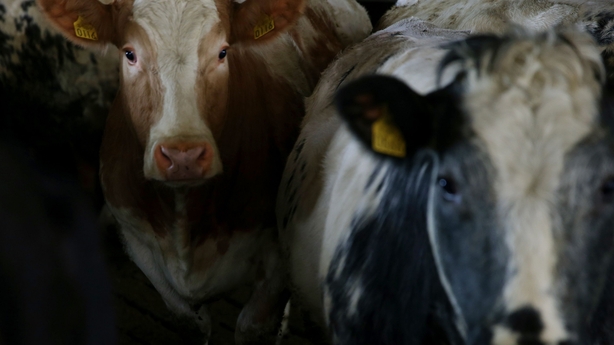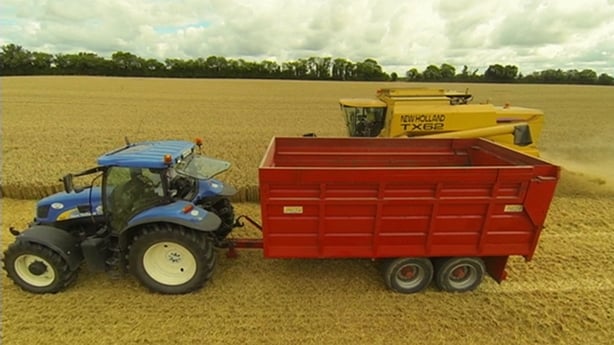You find yourself in a room. You're wide awake.
There is an elephant, a rainbow, a slice of apple pie, and an official-looking man with a weighing scales dishing out money to another guy playing a tune. Where do you think you might be?
You see you have just woken up in Brussels. It's Wednesday morning, 29 November.
You are in the EU press auditorium surrounded by journalists and EU Agriculture Phil Hogan is on stage delivering his official "Communication" about the future of the Common Agriculture Policy.
We wouldn't call it a "Communication" in Ireland of course. Here we are more inclined to call such documents "White Papers" - policy documents that governments publish in advance of big decisions and directional changes.
They are usually designed to get the ball rolling - to elicit feedback and debate from all comers about the direction policy is about to take. And that is exactly what Mr Hogan's "Communication" was all about this morning.
Titled "The future of Food and Farming" it aims to give the public a very clear indication of the principles that will guide the big decisions Mr Hogan has to take about agriculture policy.
There is little doubt it will provoke a heated debate about EU farm supports over the next 18 months.
So who, you might ask, is the official-looking guy with the weighing scales, dishing out the money at the top of the room.
It is the European Commission, of course. As the old saying goes, it is always he who pays the piper that calls the tune.
The European Commission doles out massive money to the "agriculture" piper - €40 billion per year to be precise - and this time, in terms of CAP reform, they certainly do want farmers to dance to a very different tune.
Close to seven million farmers across the European continent share in the €40bn per year of farm payments.

However, it is the top 20% who bag 80% of the money.
Mr Hogan doesn't think that is particularly fair. So he is seeking a better balance - the weighing scales in the hands of the official-looking fellow dishing out the money.
Mr Hogan is proposing to put a mandatory CAP on the amount of EU money the largest players can get in EU farm payments.
He also wants to introduce a mechanism of so called "degressive payments". That is a new term to me, but Mr Hogan makes it clear what he means by "degressive" is a system of payouts that will further reduce the financial support for larger farms.
Against all that however, the Commissioner wants to enhance the farm supports for small and medium sized farms, and to target farm payments more specifically at "genuine" farmers who have to actively farm to make a living.
That mix of guiding principles is likely to be broadly welcomed by farmers here in Ireland, where the average farm size is about 32 hectares and the average family farm income is in region of just €24,000 per year.
But what about that rainbow we saw when we woke up earlier in the room?
Well it’s all to do with the strict environmental and climate obligations that the EU fully intends to knit right into the heart of the Common Agriculture Policy.
Climate change is the biggest challenge facing mankind and the European Union is leading the way in terms of efforts and commitments to tackle it.
The EU has committed itself to a 40% reduction in greenhouse gas emissions by 2030.
Sustainability is to become the name of the game for European agriculture in the 2020s.
What that means is that farmers in all corners of the community will be called in to crank up the environmental functions they already deliver.
Ecosystem services related to soil, air quality, water, bio-diversity, and landscapes amenities will become more essential.
Today’s commission document says that the granting of farm supports will become conditional on the delivery of those wider environmental benefits.
On that note, however, Mr Hogan is all too aware that the bureaucracy surrounding such environmental obligations drives most farmers around the twist.
They constantly complain about "red tape" and what they deem to be silly rules caused by a one-size-fits-all approach to environmental schemes.
The core complaint is that EU rules dictate what farmers can do: things such as cutting hedges, spreading slurry, and much more. And because those rules do not take account of local and regional conditions and weather variations they do, at times, seem particularly silly to Irish farmers.
The commissioner has a solution for that.
From 2020, he is going to allow local governments to have a far greater say in designing, policing and regulating the environmental schemes that farmers have to deliver on.
His hope is that this will solve the complaints about EU bureaucracy.
However, there is no guarantee that state-designed environmental schemes for farmers will be free of the kind of red tape and bureaucracy that have dogged the EU schemes to date.
That brings me to the "apple pie" in the room.

Well it is more "motherhood and apple pie" that we saw when we woke up earlier - and there was a lot of that in terms of farm policy objectives in the communication document launched by the EU Commissioner today.
There is lots of stuff in the document that that nobody would disagree with.
There is the need to do more to get younger people into farming, to encourage older farmers to pass on their land.
The guiding principle on that front suggests that more money and farm support payments will be provided to support those objectives.
Smart farming, encouraging innovation, encouraging the adoption of new technology spreading the latest knowledge about framing techniques are all to be catered for.
New efforts are also to be made to improve the position of farmers in the European food-price chain - to ensure they get a better share of the money that consumers have to fork out for their produce on supermarket shelves.
None of that stuff is particularly new from an Irish perspective but it is reassuring for farmers to see it all underscored as guiding principles in the Common Agriculture Policy going forward.
So what about the elephant that I mentioned at the beginning?
Yes of course, there is an elephant in the room in relation to CAP, and a great big elephant it is too.
The elephant in the room is Brexit - a huge big important issue of enormous significance that cannot be mentioned in official documents.
The UK is currently the second largest contributor to the EU Budget. When it leaves the European Union it will take that financial contribution away.
It is worth about €18 billion gross, and right now nobody has any idea how the European Commission is going to plug the financial gap that will result.
Agriculture currently accounts for almost 40% of the EU budget spending.
The biggest fear that farmers have right now is about what will happen to their farm payments when the UK leaves.
The solution according to most farm groups is to ask European governments to cough up more - to raise their contributions to the EU budget so that farm payments can be protected.
But there have been no discussions about all about any of that and Commissioner Hogan said today that EU President Junker ordered him not to include any mention about money in his communication paper this morning.
There was no mention either about the fallout in terms of trade patterns when the UK departs. What impact will all that have on agriculture prices, tariffs, and customs?
It has the potential to be extremely disruptive to farm enterprises and if it were to go badly, it could make it far harder for farmers in Ireland to deliver on the environmental commitment that the EU is so desperate to put at the heart of the CAP in the 2020s.
When it comes to CAP reform Brexit is a classic "elephant in the room" - a huge big important issue that cannot be mentioned in official documents.







